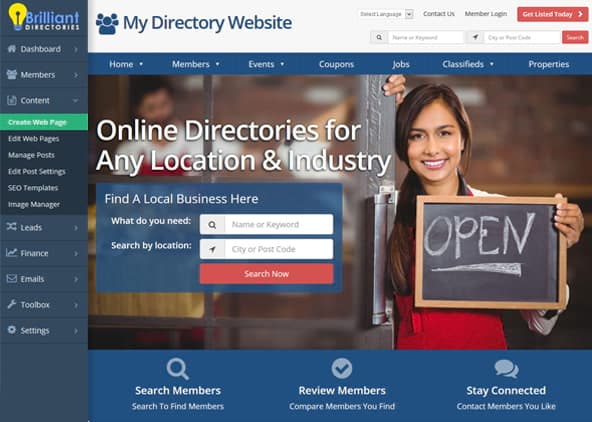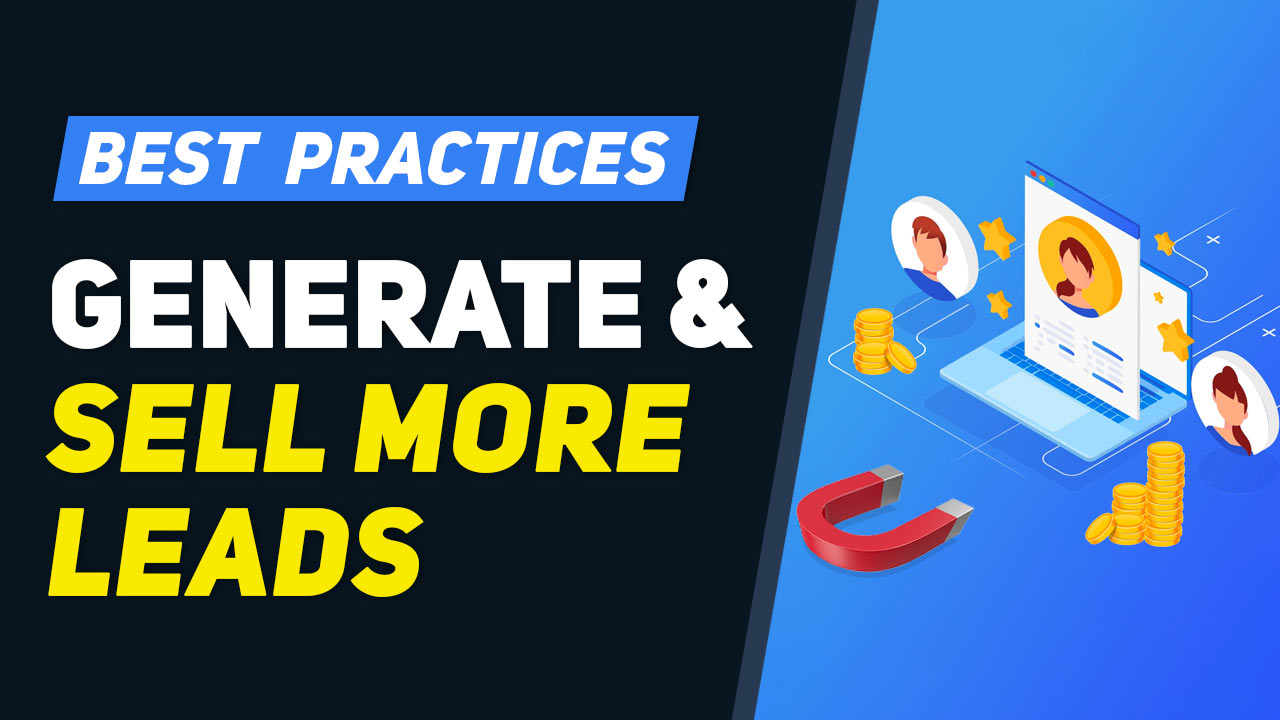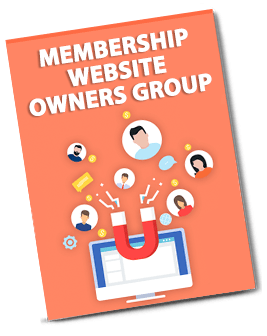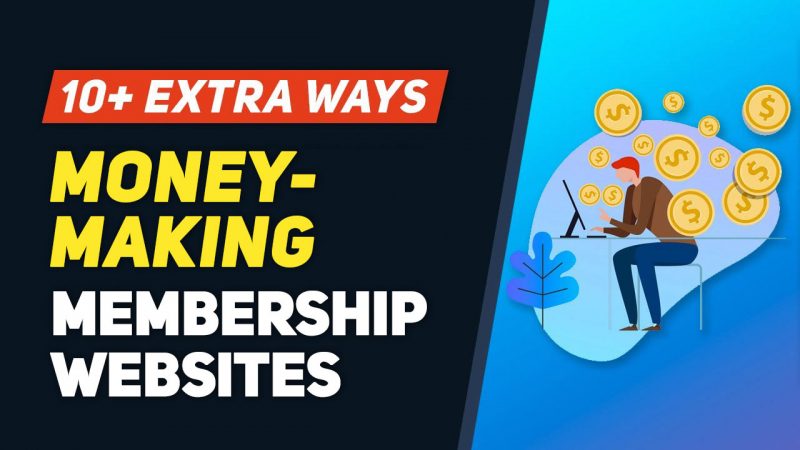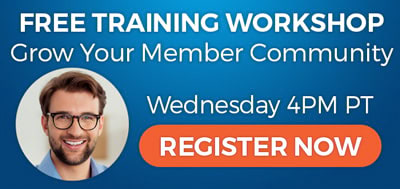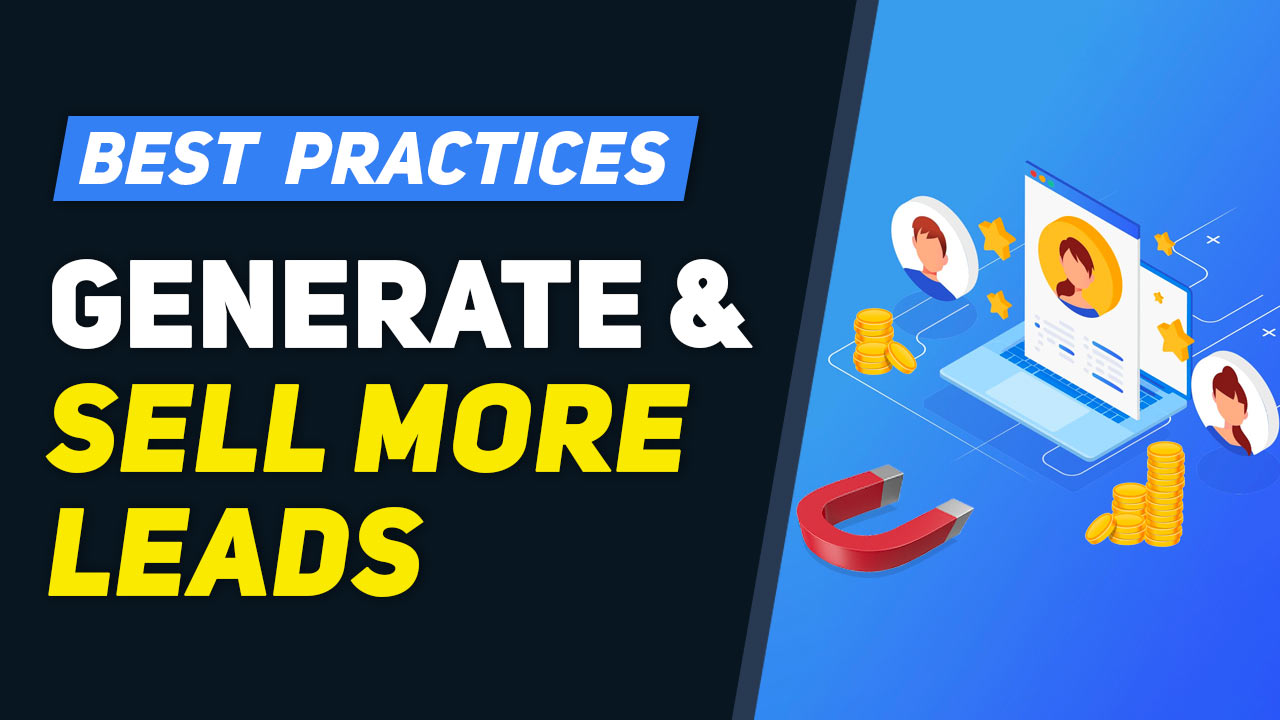
This Tip of the Week covers topics including:
- 0:52 – What is a “Lead”?
- 1:44 – Types of Websites that Generate Leads
- 5:30 – Ways to Generate Leads
- 7:45 – How Cory Barnes Uses Facebook Groups To Grow His Membership Website
- 9:42 – Educating Your Visitors is Key!
- 14:18 – Educating Your Members is Key!
- 18:26 – Let’s See a Sample “About Our Service” Page
- 27:05 – Direct Leads vs. Indirect Leads
This is a segment from Webinar Wednesday 141, recorded live on August 24, 2022.
What is a Lead?
A lead refers to a potential customer or client that has shown interest in a particular product or service. In the context of business listing websites, a lead is typically generated when a website visitor submits their information, such as their name, phone number, or email address, in exchange for more information about a specific business.
Types of Websites that Generate Leads
Lead generation websites can range from business directories and review sites to local search engines and classified ads platforms. Any website that aims to connect potential customers with businesses can generate leads.
Ways to Generate Leads
Leads can be generated through various means, including but not limited to:
- Submitting a contact form on the website
- Signing up for a newsletter or email list
- Downloading a whitepaper or other resource
- Requesting a consultation or quote
- Registering for an event or webinar
Educating Website Visitors
In order for a business listing website to effectively generate leads and sell them to their business members, it’s important for the website to educate its visitors about the lead generation process. This can include:
- Clearly displaying a call-to-action (CTA) that encourages visitors to submit their information in exchange for more information about a specific business
- Providing a clear and concise explanation of how the lead generation process works, including what information will be collected and how it will be used
- Ensuring that the website is secure and that visitors’ information is protected and not shared without their consent
Educating Business Members
It’s also important for the business listing website to educate its business members about the lead program and how they can effectively use the leads generated by the website. This can include:
- Providing regular reports or updates on the number of leads generated for each business and their contact information
- Offering training or support on how to effectively follow up with leads and convert them into paying customers
- Providing a clear and detailed FAQ section that explains the lead program and how it works, including how leads are generated, how they are sold, and what the costs are
You Can Do This!
By educating both its website visitors and business members, a business listing website can effectively generate and sell leads, helping its business members grow and succeed.

 AI-Generated Transcript – Please excuse any inaccuracies
AI-Generated Transcript – Please excuse any inaccuracies
What is a “Lead”? (00:00:52)
- A lead is defined as a person or thing that may be useful, especially if it’s a potential customer or a business opportunity (00:00:53)
- Other terms that can be used to refer to leads include referrals, prospects, applicants, opportunities, and introductions, which involve introducing a lead or potential client to a member (00:01:08)
- In the context of a business directory, leads would be potential customers or clients for the business members, who are businesses or professionals offering their services (00:01:24)
- The concept of a lead is important for businesses, particularly those with membership websites, as it can help generate and sell more leads to members (00:00:59)
- Leads can come in various forms, but ultimately, they represent a potential opportunity for a business or professional to gain a new customer or client (00:01:12)
Types of Websites that Generate Leads (00:01:44)
- Lead generation models for directory and membership websites involve generating leads of potential customers and clients for members, and then selling those leads to members, providing them with contact information to follow up with potential clients (00:01:44).
- These lead gen websites provide leads to their members within their network, and website owners can either provide these leads for free or sell them to members for a certain price (00:02:11).
- Examples of websites that generate leads include business or service directories, such as attorney directories, doctor directories, and home repair directories, like Angi Inc., which provide contractors and service providers with potential new clients (00:02:31).
- Leads can also take additional forms, such as Real estate websites providing Realtors or agencies with prospective property buyers and sellers, classifieds websites bringing potential buyers to members selling items, and employment websites like LinkedIn, Indeed, or Monster, which provide employers with job applicants (00:03:09).
- The goal of lead generation and distribution is to get information from potential customers or clients and provide their contact information to members, who can then follow up with the individual to try to get their business (00:04:07).
- Many website owners, especially those starting a directory website, aim to sell leads to their members, but often fail to convince and compel visitors or professionals to use their website, which will be covered in the next few slides (00:04:41).
- A simple example of a lead generation website is a site to find dog walkers, which connects dog walkers with people who need the service, but website owners need to convince both parties that their website is the best platform for this connection (00:04:48).
Ways to Generate Leads (00:05:30)
- To generate leads, it is essential to find where the desired leads or prospects spend their time online and make it clear to them that the website is a valuable resource for them, which can be achieved by creating content that is relevant to their interests, such as a dog walker directory or a Real estate listings website (00:05:31).
- Creating a website that provides valuable resources for the desired leads, such as a dog walker directory or a real estate listings website, can help attract potential clients for the members, and this can be done by providing content that is relevant to their interests, such as information about dog walking or home buying and selling (00:05:42).
- Another way to generate leads is by creating content that is relevant to the desired leads, such as information about remodeling, interior design, curb appeal, or staging, and then getting this content in front of the desired leads through various means, such as paid ads on Google, Microsoft Bing, or social media (00:06:15).
- Paid ads, such as PPC or paid ads on social media, can be an effective way to generate leads, but it is crucial to ensure that the ads are only paid for on platforms where the desired leads are actually spending their time, such as Instagram for pet owners or Facebook for potential home buyers (00:06:54).
- Identifying the platforms where the desired leads spend their time online is critical to generating leads effectively, and this can be done by researching the demographics and interests of the target audience, such as pet owners or home buyers, and then creating ads that are appealing to them on the relevant platforms (00:07:17).
- Social media platforms, such as Instagram or Facebook, can be a great opportunity to generate leads, especially if the content is relevant to the interests of the desired leads, and by getting the content in front of them through paid ads or organic reach (00:07:40).
How Cory Barnes Uses Facebook Groups To Grow His Membership Website (00:07:45)
- Cory Barnes has successfully turned his local business directory website into a massive success, generating over six figures by utilizing Facebook groups to generate leads and sending them to his professional members listed on his website (00:07:45).
- He has been a great help in the community, answering questions in the Facebook group and providing great resources, which has contributed to his success and can be a great example to learn from (00:07:53).
- Targeted Landing page can be used to bring leads to professional members, and these pages can be ranked organically in search results or used in conjunction with paid ads to direct leads to the website (00:08:36).
- The targeted landing pages can provide valuable information and resources to potential leads, such as pet owners, and make it clear that the website has a network of trustworthy and verified professionals, such as dog walkers, that can be hired (00:09:00).
- The use of targeted landing pages and calls-to-action (CTAs) on the website can help make it clear what potential leads stand to gain from spending time on the website and utilizing its resources (00:09:27).
- Cory Barnes’ success and strategies can be a great insight into creative ways to utilize additional platform forms to bring leads to professional members, and his story can be a valuable example to learn from (00:08:21).
Educating Your Visitors is Key! (00:09:42)
- Educating visitors is crucial to maximize revenue and sell out leads, and this can be achieved by considering four key items: trust, expectations, calls to action, and follow-up, which are essential to make visitors understand the value of the service (00:09:42).
- Building trust with visitors can be done by utilizing testimonials and social proof to show that many other visitors have found success in finding professionals through the verified network, which helps to establish the website as a valuable resource (00:10:45).
- Setting expectations for visitors is important, and this can be done by making it clear that the website is an expert in matching visitors with qualified professionals, and that visitors will be matched with a limited number of professionals, such as five, to avoid overwhelming them with too many options (00:11:16).
- Using calls to action throughout the website and in paid ads can help to encourage visitors to take action, such as getting connected to professionals within the network, comparing quotes, and finding the best professionals for their needs (00:12:04).
- Following up with visitors is essential to ensure they are satisfied with the quantity and quality of the professionals they were matched with, and to gather feedback and suggestions for improvement, which can help to further improve the service and grow the business (00:12:37).
- The overall goal is to convince and compel visitors to fill out the lead form and provide leads to members, which can be achieved by using testimonials for trust, setting expectations, and having clear calls to action, such as “get matched now” or “request a quote now” (00:13:25).
Educating Your Members is Key! (00:14:18)
- Educating members is key to generating and selling more leads, and this involves building trust by providing legitimate and vetted leads, which is crucial when selling potential clients’ or customers’ contact information to businesses, so they can follow up and try to get that business (00:14:18).
- Members need to have clear expectations about what they will be paying for and what the process of purchasing or receiving leads is like, whether leads are sold or provided for free, and they need to know that the leads are legitimate (00:14:29).
- Follow-up is essential for professional members, as it ensures they are satisfied with the quantity and quality of leads they receive, and it allows for open communication and potential refunds or credits for bad leads (00:16:02).
- Having fair lead prices is vital, and these prices should be calculated based on the industry being served, taking into account the potential profit for members and the average conversion rate of leads (00:16:53).
- The pricing of leads can vary significantly depending on the industry, with higher-priced leads being more suitable for industries like law, where the potential revenue gain is higher, and lower-priced leads being more suitable for industries like dog walking (00:17:10).
- Considering the average conversion rate of leads and the potential member profit can help determine the optimal pricing for leads, with higher conversion rates and higher potential profits allowing for higher-priced leads (00:17:33).
- Educating members about the lead generation process and the value of the leads they receive is crucial for building trust and ensuring the long-term success of the membership website (00:18:23).
Let’s See a Sample “About Our Service” Page (00:18:26)
- The lead matching service should be advertised to both members and visitors on the site, with a focus on the benefits of receiving direct inquiries and the potential for converting leads into paid customers (00:18:30).
- Brilliant Directories was built as a lead matching platform over 12 years ago, initially targeting a specific market and industry, and was successful in selling leads to that market (00:19:09).
- The site had various features, including a full mini website for member profiles, allowing them to upload portfolios and galleries, and providing links to their website and social media (00:20:09).
- Members were also offered perks such as the ability to connect and network with fellow professionals, improve their search engine rankings, and receive training on how to market their company (00:20:41).
- The site’s design and messaging were focused on increasing online visibility and providing compelling and convincing text to attract members (00:21:10).
- A client referrals tab provided information on the leads that members could receive, with a matching service that connected consumers with interior designers (00:21:28).
- The site verified client referrals by calling leads to confirm their legitimacy, which helped build trust with designers and resulted in higher sell-through rates (00:21:48).
- The website offered verified client leads, providing more opportunities for interior designers to get clients, and they invested heavily to attract these clients, with a system in place to notify designers whenever referrals came in, allowing them to keep 100% of their fees (00:22:27).
- The website had a page dedicated to frequently asked questions about leads, which showed full transparency to interior designers and professionals, addressing questions such as how leads are different from other sites, lead costs, and how many leads professionals can expect to get (00:23:43).
- The website limited the number of professionals who could purchase a lead to three, to prevent cannibalizing their opportunity to make a sale or pitch the client, and leads cost $24 for basic listings, with a discount of $12 for Pro listings (00:24:25).
- The website generated recurring revenue from Pro listings, which offered more visibility on the site and a discounted rate for leads, and the number of leads professionals could expect to get depended on various factors, with leads being opportunities, not guarantees, to land new customers and clients (00:25:01).
- The website screened leads by calling them to ensure they were legitimate, which eased the minds of interior designers and helped build trust with them, and they addressed concerns about lead quality and conversion rates upfront (00:25:47).
- To generate and sell more leads to members, it is essential to screen the leads and call them to extract more information about their projects, which can help increase the value of the leads and make them more attractive to potential buyers (00:26:00).
- Editing the lead details and providing more information about the project can make it more appealing to designers who want to be part of the purchase, as it can turn out to be a bigger project than initially thought (00:26:05).
- Having a refund or credit policy in place can help address the issue of bad leads, where the phone number may not be working, or the lead may not be legitimate, and this policy should be easy and straightforward (00:26:29).
- Creating an FAQ page about lead services and a page that sells members on joining the site can help provide essential information to members and potential buyers, including details about verified client referrals or leads (00:26:50).
- Providing a clear and comprehensive overview of the lead services, including the process of screening and verifying leads, can help build trust with members and increase the chances of selling more leads (00:26:51).
Direct Leads vs. Indirect Leads (00:27:05)
- Direct leads are those that are submitted on the member’s profile page, where a consumer can send a message or request a quote, and this can be customized to fit the member’s needs, such as changing the text to “request a quote” (00:27:09).
- The member’s profile page can also include a file upload add-on, which allows consumers to upload images of their projects, making it easier for members to receive detailed leads (00:28:14).
- Indirect leads, on the other hand, come from Landing page that are designed to convince and compel consumers to get free quotes, and these leads can be matched with members based on category or location (00:30:08).
- A lead gen theme can be used to create a website that pushes people to get free quotes, and this can be combined with pages that explain the benefits of joining, such as increased visibility and client referrals (00:28:40).
- The consumer-facing side of the website should have a clear and simple landing page that allows consumers to fill out a form to get quotes, and this page can include testimonials, bullet points, and other convincing elements (00:29:26).
- The lead gen form can be used to match consumers with qualified members based on their location and category, and this can be done by filling out a form with the consumer’s information, such as their location, and then matching them with members who fit their needs (00:30:12).
- To effectively sell leads to members, it’s essential to have a website that addresses questions, establishes authority, and clearly communicates the benefits of using the service, making it clear to both members and consumers that they are in the right place (00:30:40).

